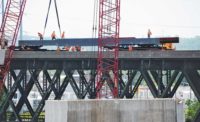Bertha remained berthed. Experts droned on about drones. Bridges sported cracks or got built fast. Dogged attempts to build high- or higher-speed rail around the nation started to make progress. A multiyear transportation funding bill at long last passed through Congress. And, fueled by the emerging millennials and the retiring baby boomers, developments oriented around transit, walking and biking are, well, booming.
Public-private partnerships and concessionaire contracts are finally maturing in the U.S., ranging from the East End Crossing in Louisville to a $2.8-billion purchase of Chicago’s Skyway Toll Road. Four teams are contending for a P3 transit project in Maryland, which would be the second of its kind after Denver’s Eagle P3 project, which is nearing completion.
ENR visited Louisville and Denver during a three-week road trip in a 1949 Hudson that served as a rolling metaphor for the aging of America’s infrastructure. And for this reporter, learning to co-exist and collaborate with the author Dan McNichol, whom she had barely met, became a living metaphor reflecting how agencies, contractors, engineers and other stakeholders have to pull together to complete a mission no matter what their occasional personality clashes.
The tour included a streetcar project in Kansas City, the construction of a park-bridge that will connect the St. Louis Arch to downtown, a $1-billion airport expansion taking off in Salt Lake City and the $900-million Folsom Dam upgrade in California. The commissioner of the Missouri Dept. of Transportation discussed the agency’s budget woes and the painful decision to simply let some bridges and highway sections stay in a state of not-good repair.
Other unfortunate transportation moments in 2015 included the hapless Bertha, a 57.5-ft-dia tunnel-boring machine stuck for two years under Seattle, having traveled only 1,000 ft. Instead of completing the 9,270-ft-excavation by the end of this year, she got going again just in time for Christmas. Big bridge projects in the New York City area are behind schedule, but the Tappan Zee Bridge project is moving rapidly along. The governors of New York and New Jersey have agreed at long last on a sorely needed new tunnel under the Hudson River, and the long-derided LaGuardia Airport will undergo a groundbreaking $3.6-billion P3-fueled replacement.
The single biggest development in U.S. transportation was the FAST Act, a five-year bill authorizing $305 billion for transportation after multiple short-term extensions kicking the proverbial can down the (crumbling) road.
An even remotely comprehensive review of transportation developments in the U.S., let alone the globe, would take a tome. But technology—much of it disruptive—sustainability, asset maintenance and resiliency will continue to contribute to the industry’s evolution, and ENR will continue its attempts to capture some of that journey. At least, for the next few years, the broken-record quoting of frustrated officials longing for a long-term transportation bill can cease.




Post a comment to this article
Report Abusive Comment